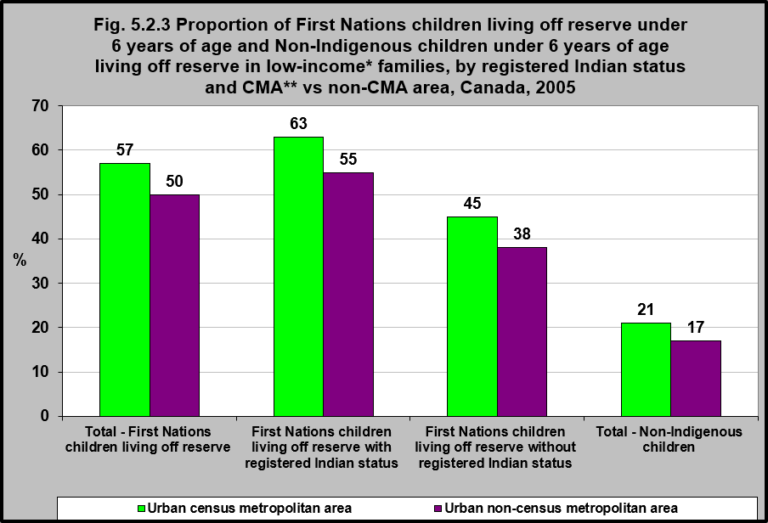Proportion of First Nations children living off reserve under 6 years of age and Non-Indigenous children under 6 years of age living off reserve in low-income* families, by registered Indian status and CMA** vs non-CMA area, Canada, 2005

Notes:
Income here refers to total income from all sources including employment income, income from government sources, pension income, investment income and any other money income received during the calendar year 2005 by persons 15 years of age and over.
*Low income before tax cut-offs (LICOs) – Income levels at which families or persons not in economic families are expected to spend 20 percentage points more than average of their before tax income on food, shelter and clothing. Economic families in the Yukon Territory, Northwest Territories and Nunavut and on Indian reserves were excluded as the low income cut-offs are based on certain expenditure- income patterns which are not available from survey data for the entire population. Although the low-income before tax cut-off (LICO) is not applicable in the territories or on Indian reserves, other Census data reveal that in 2005, the median income for First Nations people living in the Yukon was $20,300 compared to a median income of $34,951 for the non-Indigenous population. In the Northwest Territories, the median income for First Nations people was $17,558 compared to $49,219 for the non-Indigenous population.
**Census metropolitan areas (CMA) are formed by one or more adjacent municipalities centred on area (known as the urban core). A Census metropolitan area (CMA) must have a total population of at least 100,000 of which 50,000 or more must live in the urban core. Urban non- Census metropolitan areas (non-CMA) are smaller urban areas with a population 100,000.
Source: CICH graphic created using data adapted from Statistics Canada – Catalogue no. 89-634-X 16. Aboriginal Children’s Survey, 2006: Family, Community and Child Care. http://www.statcan.gc.ca/pub/89-634-x/89-634-x2008001-eng.pdf -accessed July 17, 2017.
In 2005, children under 6 living in Urban census metropolitan areas (CMAs) were more likely to live in low-income families than were those in urban non-census metropolitan areas.
This was the case for First Nations children with registered Indian status, without status or Non-Indigenous children.
However, non-Indigenous children living in CMAs were less likely to live in low-income families than were First Nations children either with or without registered Indian status.
Implications
The levels of poverty experienced by First Nations children under 6 living off reserve are much higher in the larger urban centres as compared to the smaller ones. This has left unemployed and low-income households less protected, having to work more for lower wages and take on more debt.1
1Walks, A. (2013). Income inequality and polarization in Canada’s cities: An examination and new form of measurement. Toronto, ON: University of Toronto, Cities Centre, Research paper 227, p. 3 and 91.
